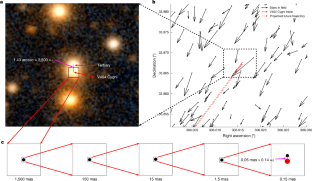2024-10-23 カリフォルニア工科大学(Caltech)
<関連情報>
- https://www.caltech.edu/about/news/first-black-hole-in-a-triple-star-system-found
- https://www.nature.com/articles/s41586-024-08120-6
ブラックホール低質量X線連星V404 Cygniは広い三重星の一部である The black hole low-mass X-ray binary V404 Cygni is part of a wide triple
Kevin B. Burdge,Kareem El-Badry,Erin Kara,Claude Canizares,Deepto Chakrabarty,Anna Frebel,Sarah C. Millholland,Saul Rappaport,Rob Simcoe & Andrew Vanderburg
Nature Published:23 October 2024
DOI:https://doi.org/10.1038/s41586-024-08120-6

Abstract
Evidence suggests that, when compact objects such as black holes and neutron stars form, they may receive a ‘natal kick’, during which the stellar remnant gains momentum. Observational evidence for neutron star kicks is substantial1,2, yet is limited for black hole natal kicks, and some proposed black hole formation scenarios result in very small kicks3,4,5. Here we report that the canonical black hole low-mass X-ray binary (LMXB) V404 Cygni is part of a wide hierarchical triple with a tertiary companion at least 3,500 astronomical units (au) away from the inner binary. Given the orbital configuration, the black hole probably received a sub-5 km s−1 kick to have avoided unbinding the tertiary. This discovery lends support to the idea that at least some black holes form with nearly no natal kick. Furthermore, the tertiary in this system lends credence to evolutionary models of LMXBs involving a hierarchical triple structure6. Remarkably, the tertiary is evolved, indicating that the system formed 3–5 billion years ago and that the black hole has removed at least half a solar mass of matter from its evolved secondary companion. During the event in which the black hole formed, it is required that at least half of the mass of the black hole progenitor collapsed into the black hole; it may even have undergone a complete implosion, enabling the tertiary to remain loosely bound.



